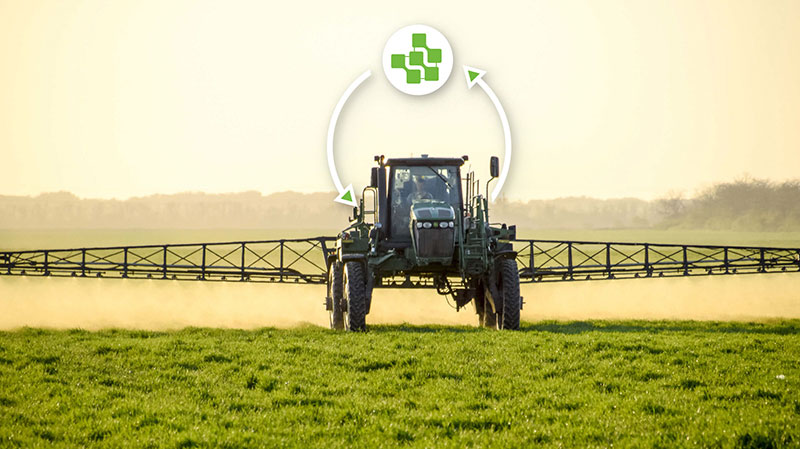LandScan Secures Precision Agricultural Industry’s First Digital Twin Patent
LandScan, the global leader in digital twins in agricultural technology and precision farming solutions, is proud to announce the grant of its latest patent, (US 12,092,625), titled “Precision Site Characterization Using Digital Twin”. This groundbreaking patent marks the first of its kind in the agriculture sector, involving the use of digital twin technology to revolutionize site characterization and precision farming practices.
A New Era in Agriculture
The advent of digital twin technology in agriculture represents a significant leap forward in how farmers, agronomists, and researchers understand and manage cropping systems. Digital twins are virtual models that accurately replicate physical objects and/or environments, allowing for in-depth analysis, simulation, and modeling without interfering with real-world operations. By applying this technology to agriculture, LandScan is empowering decision support to optimize precision farm management, improve crop yields, and objectively and quantitatively measure the outcomes of regenerative agricultural practices.
“We are thrilled to have secured this patent, which solidifies our position as the pioneer in agricultural digital twin technology,” said Dan Rooney, CEO of LandScan. “Our technology for precision site characterization and analysis will provide unprecedented insights into agricultural environments, helping farmers make more informed decisions, reduce resource use, increase productivity, and provide objective metrics for soil health and sustainability baselining and monitoring.”
The Digital Twin Patent
The newly patented technology leverages a combination of advanced and unique soil and remote sensing technologies, machine learning and AI, and simulation techniques to create a virtual and objective representation of an agricultural site and farming system.
Key features of the patent include:
- High-Resolution Data Analysis: Utilizing data from multiple sources, including satellite imagery, drones, and ground sensors, the digital twin provides a high-resolution analysis of the site. This enables precise monitoring of dynamic soil conditions including fertility and chemistry, moisture levels, and crop health.
- Predictive Modeling: The digital twin allows for predictive modeling of various farming scenarios. By simulating different planting, irrigation, and fertilization strategies, farmers can optimize their practices for maximum yield and resource efficiency.
- Dynamic Adaptation: As conditions change over time due to weather or other environmental factors, the digital twin adapts to reflect these changes, providing up-to-date information and recommendations for site management.
- Integration with Precision Farming Tools: The technology can be integrated with existing precision farming tools, such as GPS-guided equipment and variable rate technology (VRT), to execute site-specific management practices seamlessly.
- Sustainability and Resource Management: By enabling more efficient use of water, fertilizers, and other inputs, the digital twin enables regenerative farming practices and helps reduce the environmental impact of agriculture.
Industry Adoption and Impact
The introduction of digital twin technology into agriculture is transforming the industry by providing a more detailed, objective, and dynamic understanding of cropping systems. Traditional methods of site characterization, such as lab-based soil sampling and field scouting, are labor-intensive, time-consuming, and limited in scope, accuracy, and repeatability. The use of digital twins allows for a more holistic and continuous assessment of the site, leading to better decision-making and resource management.
Olam Food Ingredients (OFI), a world-leading nut supplier, has been an early adopter of LandScan’s technology. “LandScan’s digital twin technology has had a significant and practical impact on our almond production in the US with immediate and measurable ROI, and we are excited about its expansion into our Australian operations in 2025”, said Zac Ellis, OFI Senior Director of Agronomy.
Similarly, Mars has been working closely with LandScan to integrate digital twin technology into their operations. “Mars is excited to begin working with LandScan’s digital twin technology for the purpose of optimizing international cocoa production and providing important soil health sustainability metrics for our supply chain,” said Greg Hocking, VP Global R&D New Innovation Territories at Mars Wrigley.
Future Applications and Developments
LandScan’s patented technology platform creates a wide range of possibilities for future applications and developments in agriculture. Beyond its immediate use in precision site characterization, digital twin technology has the potential to be applied to other aspects of farming, such as supply chain traceability and understanding the relationship between crop genetics, the growing environment, and management practices. By continuously refining and expanding the capabilities and intellectual property portfolio around digital twins, LandScan intends to stay at the forefront of innovation in agricultural technology.
“We see this patent as just the beginning,” added Dan Rooney. “Our goal is to further develop and integrate digital twin technology across all aspects of farming, creating a fully connected and intelligent agricultural ecosystem.”





